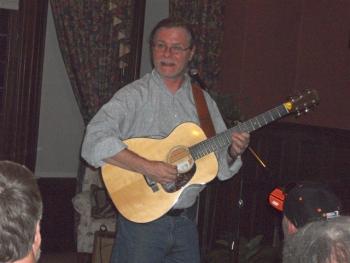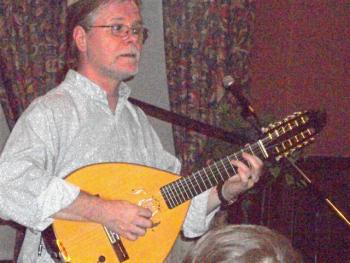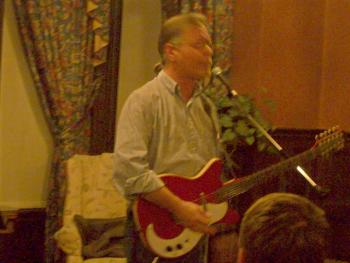RGC's First Meeting in the Red Room at Asbury Church Featuring John Covach in Presentation, March 19, 2012
On Monday night, March 19, 2012, RGC held its first meeting in the new meeting place at 1010 East Ave in Rochester, a terrific and inviting spot for the Club. That night, those in attendance were treated to an informative and entertaining talk, and the longest Q & A session on record by guitarist, John Covach, music historian and head of the U of R Music Theory Department. John’s topic was “Rock Guitarists and Their Use of Classical and Fingerstyle Techniques.” His talk focused on the emerging rock music of the 1970’s and covered notable bands, players and historic moments of the period.

Central to Covach’s talk was the notion that each generation’s pop music often starts with cycles of simplicity and evolves towards complexity. New music cycles tend to begin either as a backlash response to the preferred music of parents or older siblings, or as a shift towards new sounds, compositional styles, technical possibilities, a shift in media or all of the above. Ultimately, each musical age tends to follow the same path: starting with simpler music forms, then maturing, as both musicians and their audiences develop a taste for complexity.
In the late 1950’s and the early 1960’s doo-wop bands and singer/songwriter rock bands sprang onto the scene. The sound of big bands began to recede. Orchestral driven pop songs were soon making room for simpler music and, at first, simpler playing. With the Beatles’ arrival, do-it-yourself songwriting and a focus on guitar playing became the norm. And with the emergence of the counter-culture the new, simple pop music began an evolution that would ultimately produce virtuosic guitar playing, and along the way, examine its roots, among them classical guitar.

Noting the Beatles’ influence, Covach observed that George Harrison’s playing on a Rickenbacker twelve-string electric guitar in The Beatles movie “A Hard Day’s Night” inspired The Byrds’ guitarist Jim McGuinn to buy one. Shortly thereafter, he used it on the now famous folk-rock anthem “Mr. Tamborine Man,” thus launching the ‘jingle-jangle’ sound of the folk-rock era. With Harrison’s use of classical guitar on “And I Love Her,” (also in “A Hard Day’s Night”) and for the solo in “’Till There Was You,” the classical guitar gained notice on the pop scene, peaking perhaps in the 1960’s with Mason Williams’ “Classical Gas” and Jose Feleciano’s “Light My Fire.” Interestingly, while Andrés Segovia may have set out to “rescue the classical guitar from the gutter of pop and folk music;” it is ironic that, as a guitar hero of George Harrison, Segovia and his beloved classical guitar found new voice and advocacy in the hands of a new generation of pop musicians.
As the Beatles and other bands of the period matured, notably Hendrix’ and Cream, pop music gradually moved from entertainment to art form. By the 1970’s pop guitar playing itself was moving towards virtuosity. Simultaneously the record industry was morphing from the two and a half to three-minute restriction of the single sided 45-rpm disc to the expanded freedom of the two sided 40-minute 33.3 rpm LP. Radio, too, was changing and the new “now generation” of listeners was abandoning top-40 AM radio and embracing the extended and ‘open’ programming of underground FM radio, thus providing a commercial medium for the new possibilities of longer songs, complex arrangements and jamming.
Covach brought up an important element, what he called the “seriousness and purpose of the Hippie aesthetic,” pointing out that the new generation’s embracing of life’s possibilities and artistic potential had a lot to do with acceptance and encouragement of new musical ideas. Thus, with the maturing of the musicians and their audience, the aesthetic viewpoint, and the shift in the media, virtuosic guitar playing with its sometimes classical influence emerged.

Along the way, Covach treated his audience to some fine guitar playing. He brought with him his standard stage guitar-line-up of classical guitar, steel string, twelve-string, an electric guitar (in an altered tuning), and a Portuguese laúd on which he played classic bits or complete songs. Covach spent a considerable amount of time on the classically influenced contributions of Steve Howe from the ‘70’s era band Yes. Among the songs played were the opening refrain from “Mr Tamborine Man,” Pink Floyd’s “Wish You Were Here,” Steve Howes’ “Clap” (sometimes mistakenly called “The Clap”) and a number of other tunes: Yes’ “And You And I,” and “Mood For A Day;” “The Rain Song” from Led Zepelin; and the Beatles’ “Norwegian Wood.”
Cycles of simplicity, backlash responses to previous music, search for identity and uniqueness, a focus on seriousness and eventual virtuosity as well as the political and social currents of the time all contributed to the evolution of 70’s era pop music and guitar playing.
But change is inevitable. The harvest of the British Invasion, and blossoming of folk-rock, Allman Brothers‘ southern rock, Grateful Dead-style jam bands, jazz fusion and all the other permutations and contributions of the era of the “hippie aesthetic” eventually gave way to the musical and commercial interests of successive generations: disco, punk, grunge, rap and even today’s country music have all sprung from successive generations, each with its cycle of simplicity and development, and each generation tending to remain loyal to its coming of age music.
~Kinloch Nelson
Photos: R. Taglieri
Share this page: ![]() Facebook
Facebook
![]() Del.icio.us
Del.icio.us
![]() StumbleUpon
StumbleUpon
![]() Digg
Digg
![]() Reddit
Reddit
Home ::
About Us ::
Events ::
Articles ::
Resources ::
Contact Us ::
Links
©2007-2012, Rochester Guitar Club, All Rights Reserved, This page last updated 2012-05-14 11:21:02
Website by Red Beagle Web Development.








